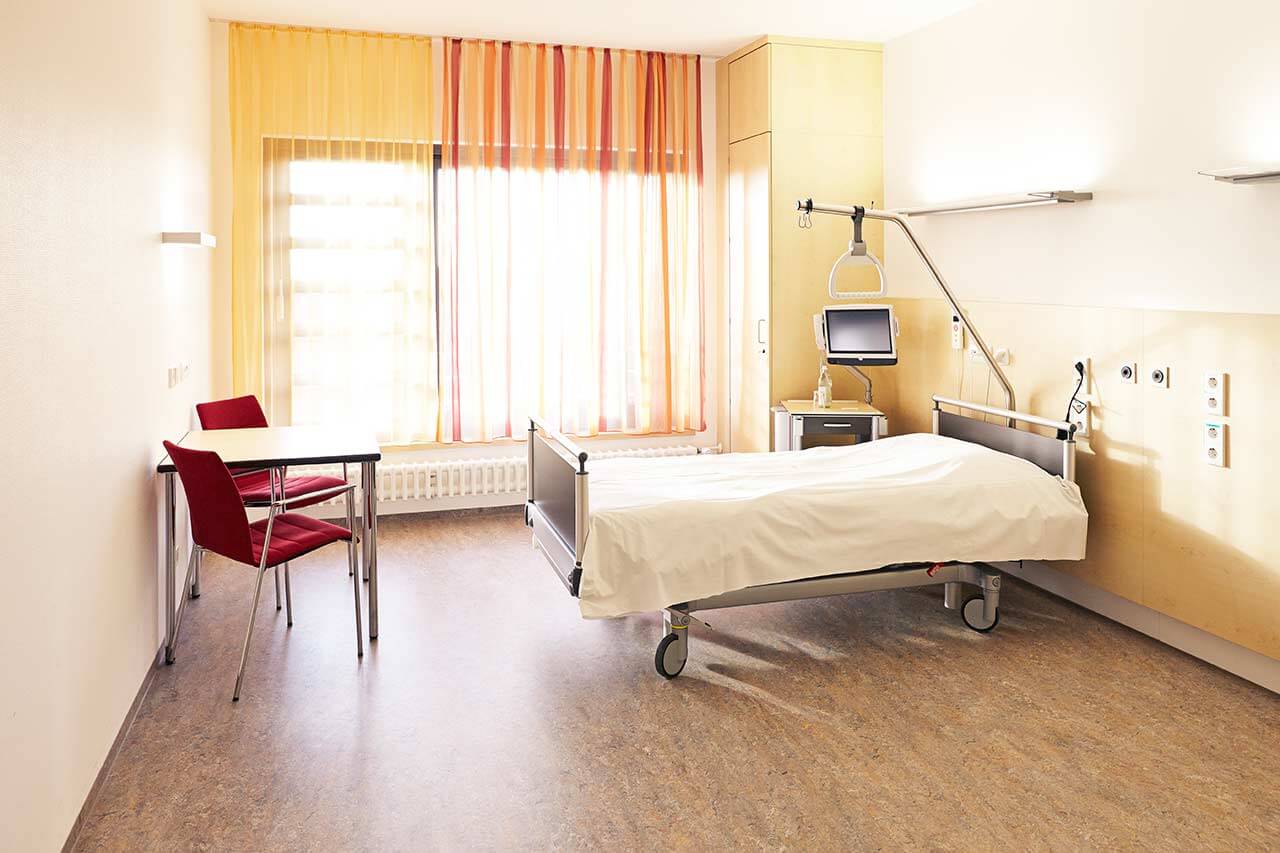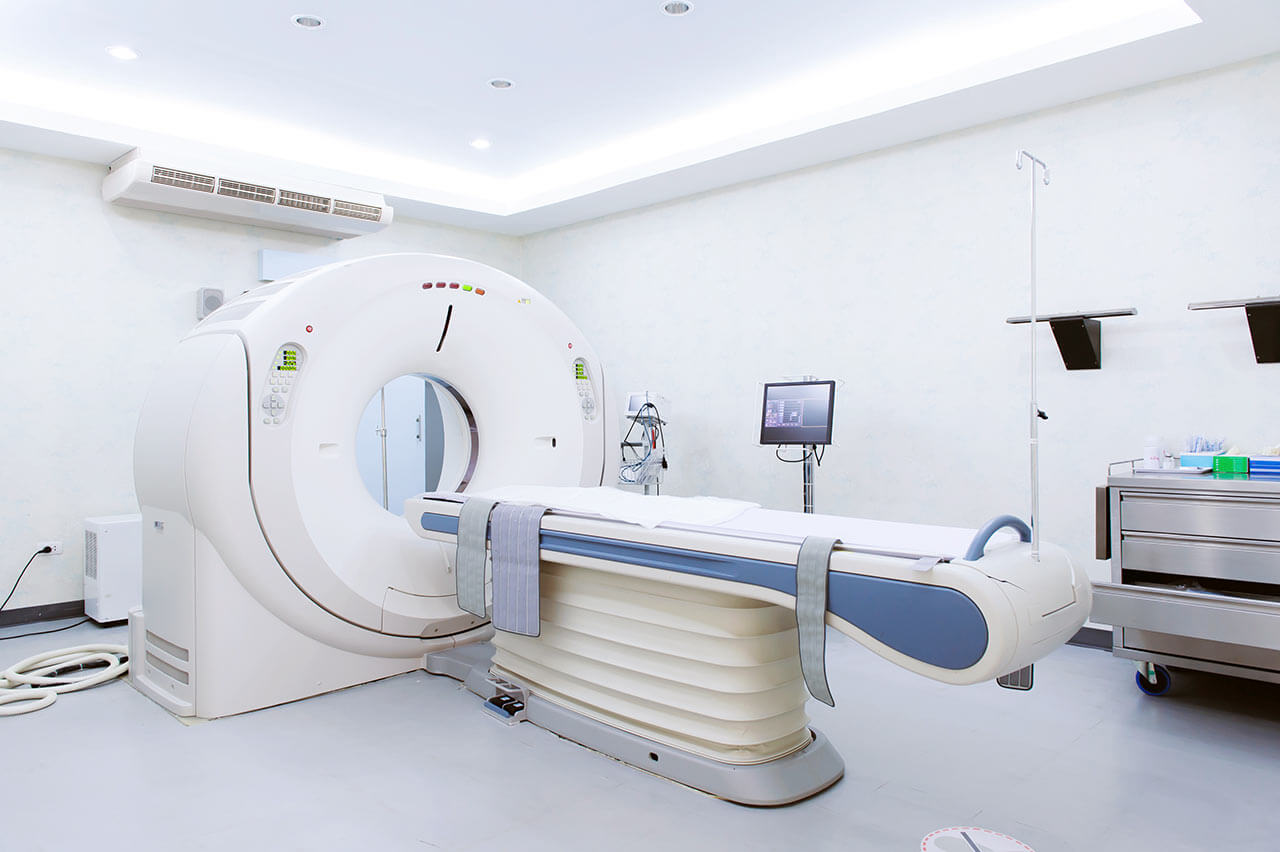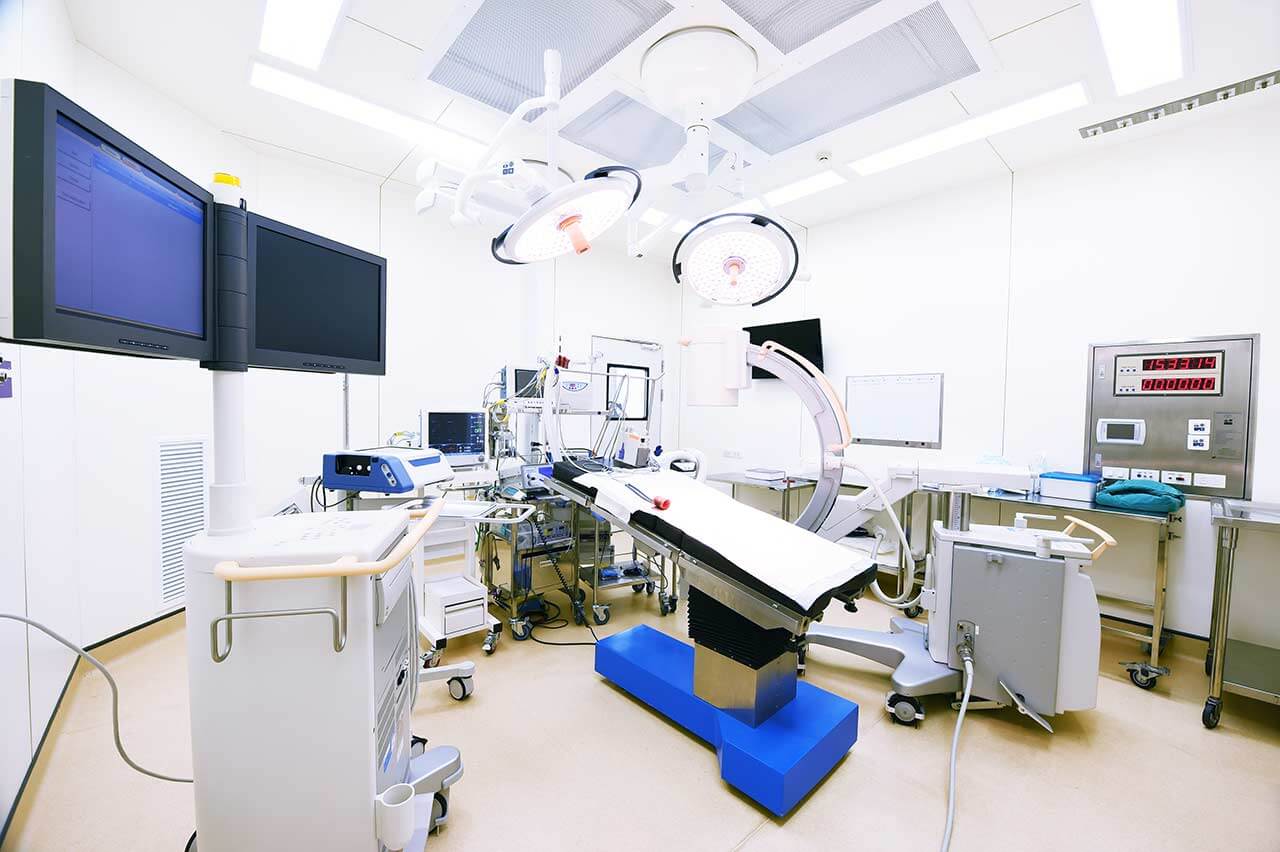
The program includes:
- Initial presentation in the clinic
- clinical history taking
- physical examination
- orthopedical examination
- x-ray of knee joint
- ultrasound of joint
- MRI scan of the knee joint (if indicated 1200 €)
- nursing services
- consultation of all leading experts
- development of individual treatment plan
Required documents
- Medical records
- MRI/CT scan (if available)
Service
You may also book:
 BookingHealth Price from:
BookingHealth Price from:
About the department
The Department of Arthroplasty at the Helios ENDO-Clinic Hamburg offers the full range of modern surgical interventions for total and partial knee, hip, shoulder, elbow, and ankle replacement surgery. The department's specialists also have vast experience in revision interventions for the replacement of artificial joints in the case of their damage, displacement, or wear, as well as septic interventions for treating joint infections. The department's surgeons annually perform more than 9,000 surgical interventions on the joints, and therefore, they have a wealth of experience, which allows them to achieve excellent treatment results. The medical facility holds a leading position at the international level in the field of joint replacement surgery. Joint surgery is performed using the very latest and most effective techniques, usually minimally invasive, due to which patients recover very quickly after their surgical treatment and experience virtually no pain. In their work, doctors use only high-quality endoprostheses, the service life of which reaches 20 years. The specialists always devote enough time to counseling patients and telling them in detail about their upcoming treatment. The department is headed by Prof. Dr. med. Thorsten Gehrke.
The department specializes in the replacement surgery of all joints, namely the hip, knee, shoulder, elbow, and ankle. The department's surgeons perform interventions in state-of-the-art operating rooms, equipped with all the technical innovations for the most effective and, at the same time, safe treatment. The operation is preceded by accurate planning, including the selection of an optimal surgical technique and the most suitable endoprosthesis, or custom-made one. Only high-quality prostheses are used in clinical practice, which are distinguished by their long service life, ranging from 15 to 20 years. The department's surgeons always give preference to innovative minimally invasive interventions. When performing joint replacement surgery, doctors often use computer navigation systems to position the prosthesis as accurately as possible, thereby ensuring its long-term service life and high treatment efficiency.
Proper postoperative recovery is required to consolidate a successful surgical treatment. For this purpose, the department uses the FastTrack concept, which allows a patient to minimize postoperative pain, as well as ensures a quick restoration of mobility and significantly reduces the duration of a hospital stay. On the day of the operation, patients already take the first steps, and a day later they are ready to perform a certain set of physiotherapeutic exercises. In the normal course of the postoperative period and in the absence of complications, a patient is discharged or sent for rehabilitation on the fifth day after the operation. It should be noted that this regimen is suitable only for 80% of patients. It all depends on a particular clinical case. The decisive factors are the age, the patient's general health condition, and the presence of concomitant pathologies.
A big advantage for patients is also the presence in the department of an in-house Bone Bank, which allows patients to restore their lost or damaged bone tissue at any time during prosthesis replacement surgery. This bank has been operating for over 40 years and provides patients with access to allogeneic (donor) grafts. The Bone Bank was designed and operated in accordance with the recommendations of the Scientific Advisory Board of the German Medical Association for Bone Bank Management and the German Medicinal Product Act.
The department's team of surgeons is also deservedly proud of their successful results in the field of revision joint replacement surgery. Such operations are aimed at replacing previously implanted prostheses in the event of their wear, displacement, infection, etc. A modern artificial prosthesis usually lasts 15-20 years, after which it needs to be replaced. After the implantation of the endoprosthesis, a patient may sometimes develop an infection that affects the artificial joint, the treatment of which requires its total removal and other therapeutic manipulations. Revision interventions are considered technically more complex than primary prosthesis placement and require a surgeon to have vast experience in this area. The department's specialists perform more than 2,000 revision knee and hip replacement surgeries each year, which is the highest rate in all of Germany.
The department's key clinical focuses include:
- Hip replacement surgery
- Primary hip replacement surgery (cemented and cementless fixation)
- Primary hip replacement surgery for dysplasia with autologous or homologous acetabular reconstruction
- Primary hip replacement surgery for post-traumatic, post-infectious and congenital deformities
- Revision interventions for aseptic prosthesis replacement (cemented and cementless fixation)
- Bone defect reconstruction using homologous and autologous bone tissues, as well as metal plates
- Pelvic bone reconstruction with rings, plates and custom-made implants
- One-stage and two-stage revision interventions for infectious prosthesis lesions
- Total hip replacement surgery
- Prosthesis implantation for extensive bone loss
- Hip soft tissue surgery (for example, in bursectomy)
- Transposition interventions for congenital and acquired deformities (triple pelvic osteotomy)
- Arthroscopic reconstruction of cartilaginous tissue and ligaments in the case of their damage, as well as bone tissue defect reconstruction in the case of femoroacetabular impingement
- Hip joint arthroscopy
- Knee replacement surgery
- Implantation of unicondylar (sliding) knee prostheses
- Implantation of bicondylar total knee prostheses
- Implantation of bound knee prostheses (custom-made endoprostheses)
- Aseptic revision knee replacement surgery
- One-stage and two-stage revision interventions for infectious prosthesis lesions
- Knee arthroscopy
- Endoscopic meniscus surgery (suturing, partial or total removal, etc.)
- Ligament plastic surgery (anterior and posterior cruciate ligament, patellofemoral ligament) for patellar instability
- Cartilage and bone tissue transplantation (OATS technique)
- Open and arthroscopic cartilage transplantation using special matrices
- Patellar correction
- Transposition tibial osteotomy for O-shaped deformity of the lower limbs
- Transposition tibial osteotomy for X-shaped deformity of the lower limbs and patellar deformities
- Shoulder replacement surgery
- Implantation of a short-rod prosthesis without cement fixation
- Implantation of rodless prostheses
- Total shoulder replacement surgery
- Implantation of inverse (bound) shoulder endoprostheses
- Aseptic and septic shoulder revision surgery
- Arthroscopic and open rotator cuff reconstruction
- Interventions on soft tissues, acromioplasty, shoulder joint stabilization
- Stabilization for acute and chronic shoulder joint tear, including autologous tendon transplantation
- Elbow replacement surgery
- Primary elbow replacement surgery
- Aseptic and septic revision elbow surgery
- Arthroscopic interventions on the elbow joint
- Ankle replacement surgery
- Upper ankle replacement surgery
- Ankle arthrodesis (upper and lower part of the joint)
- Rearfoot reconstruction
- Forefoot deformity reconstruction
- Neurolysis
- Revision surgery to replace ankle prostheses
- Forefoot and hindfoot tendon lengthening
- Achilles tendon reconstruction
- Operations for complex foot deformities, including those of rheumatic origin
- Compression syndrome treatment
- Tarsal arch reconstruction
- Transposition interventions
- Other medical services
Curriculum vitae
Higher Education and Professional Career
- 1981 - 1987 Human Medicine studies at the University of Hamburg.
- 1988 - 1989 Research Fellow, Anatomy, Institute of Anatomy, Christian Albrecht University of Kiel.
- 1989 - 1991 Assistant Surgeon at the Johanniter Hospital Geesthacht.
- 1991 - 1993 Assistant Physician, Department of Orthopedics, University Hospital Kiel.
- 1993 - 1995 Assistant Surgeon, Helios ENDO-Clinic Hamburg.
- 1995 - 1998 Assistant Physician, Department of Orthopedics, University Hospital Kiel.
- 1999 Senior Physician, Department of Orthopedics, University Hospital Kiel.
- 1999 - 2002 Senior Physician, Department of Orthopedics, Helios ENDO-Clinic Hamburg.
- 2002 - 2005 Managing Senior Physician, Department of Orthopedics, Helios ENDO-Clinic Hamburg.
- 2005 Head Physician in the Department of Orthopedics, Regio Wedel Clinic.
- Since 2005 Medical Director of the Helios ENDO-Clinic Hamburg and Head of the Department of Arthroplasty at the Helios ENDO-Clinic Hamburg.
Teaching Activities
- 1983 - 1996 Lecturer of the Gymnastics and Leisure Association (Sports Medicine), Hamburg.
- 1996 - 1997 Lecturer at the Institute of Sport (Sports Orthopedics/Sports Anatomy) of the Christian Albrecht University of Kiel.
- 2007 - 2010 Visiting Professor, Shanghai Jiao Tong University.
- 2010 - 2012 Lecturer in "Sports Medicine", Medical School Hamburg.
- Since 2013 Visiting Professor, University of Buenos Aires.
- Since 2013 Visiting Professor, University of Santiago de Chile.
Clinical and Research Focuses
- Aseptic and septic knee and hip revision surgery.
- Primary hip and knee arthroplasty.
- Sports medicine.
Memberships in Professional Societies
- Since 1990 German Association for Sports Medicine and Prevention.
- Corresponding Member of the Orthopedic Trauma Association Rosarina, Rosario, Argentina.
- European Bone and Joint Infection Society.
- Since 2000 Corresponding Member of the Asociacion Argentina para el Studio de la Cadera y la Rodilla.
- Since 2005 German Association for Arthroplasty.
- Since 2007 Honorary Member of the Asociacion Argentina para el Studio de la Cadera y la Rodilla.
- 2010 Corresponding Member of the Colombian Society of Orthopedic Surgery and Traumatology.
- Since 2013 Member of the German Knee Society.
- Since 2014 Member of the American Association of Hip and Knee Surgeons.
- Since 2014 Member of the International Hip Society.
- Since 2015 Member of the European Hip Society.
Titles and Honorary Positions
- Since 2000 Corresponding Member of the La Sociedad Boliviana de Ortopedia y Traumatologia.
- Since 2002 Honorary Professor, University of Nanjing and Qingdao, China.
- Since 2003 Corresponding Member of the Orthopedic Trauma Association Rosarina, Rosario, Argentina.
- Since 2004 Technical Consultant, Department of Orthopedics, Jiangmen Central Hospital, Guangdong Province, China.
- Since 2004 Medical Consultant of Beijing DCN Orthopedic Hospital, Beijing, China.
- Since 2004 Honorary Director of the Chinese-German International Training and Teaching Center, Yantai Yuhuangding Hospital, Shandong Province, China.
- Since 2005 Honorary Professor in the Department of Orthopedic Surgery at the Guangzhou Hospital, Shanghai, China.
- Since 2006 Visiting Professor at Al Razi Hospital in Kuwait.
- Since 2007 Visiting Professor at № 6 Clinic, Shanghai, China.
- Since 2007 Honorary Member of the Asociacion Argentina Para El Estudio de La Cadera Y La Rodilla.
- Since 2007 Honorary Professor of the Third Hospital of Hebei Medical University, Shijiazhuang, China.
- Since 2008 Visiting Professor at the Shanghai Jiao Tong University.
- Since 2008 Visiting Professor at the Shanghai Jiao Tong University, China.
- Since 2010 Lecturer of the International Course on Hip and Knee Joint Diseases, Ciudad de Medellín, Colombia.
- Since 2011 Assistant Professor of the University of Chile.
- 2012 Assistant Professor at the University of Bosse, Bogota, Colombia.
- 2013 President of the Congress of the North German Orthopedic and Trauma Surgeons Association.
- Since 2013 Corresponding Member of the Colombian Society of Orthopedic Surgery and Traumatology.
Photo of the doctor: (c) Helios ENDO-Klinik Hamburg
About hospital
According to the prestigious Focus magazine, the Helios ENDO-Clinic Hamburg ranks among the top German clinics specializing in orthopedic rehabilitation, spinal surgery, and hip surgery!
The clinic is one of the largest and most famous orthopedic medical facilities in the world. Performing more than 9,000 joint surgeries and treating more than 9,000 patients every year, the clinic positions itself as a leading healthcare facility for joint replacement surgery not only in Germany, but throughout Europe. The clinic also enjoys an excellent reputation for the surgical treatment of spinal diseases. The medical complex was founded in 1976 and its doctors have been successfully conducting their clinical practice for over 45 years, offering patients a unique clinical experience and effective treatment methods. At the same time, the clinic has a friendly and pleasant atmosphere in which patients feel as comfortable as possible.
Despite the huge popularity and high treatment success rates, the department's specialists continue to perform productive research activities to improve surgical methods and endoprosthesis models, as well as to develop innovative therapeutic methods.
The health of patients is in the safe hands of a large and competent team of highly specialized doctors, nurses, and physiotherapists, working hand in hand to ensure the best therapeutic results. At the same time, due attention is paid to a respectful attitude towards each patient and to a detailed analysis of each clinical case. The main task of the doctors is to provide each patient with an effective treatment adapted to their individual needs and to give them the joy of movement without pain.
The department's doctors have in their arsenal many sparing minimally invasive and arthroscopic techniques that ensure access to the pathological focus through several small skin incisions. Due to this, the length of hospital stay is significantly reduced, the severity of pain in the postoperative period is reduced, and the risks of complications are almost zero. On the day of the operation, a patient will be able to get out of bed on their own and take the first steps, after which the stage of mobility restoration begins.
The clinic regularly admits foreign patients from different parts of the world. This is the best confirmation of the high level of medical care and the success of therapy.
Photo: (с) depositphotos
Accommodation in hospital
Patients rooms
The patients of the Helios ENDO-Clinic Hamburg live in modern single and double rooms with all the conveniences. Each patient room has an ensuite bathroom with a toilet and a shower. The patient rooms are designed in bright colors and feature large windows that offer a pleasant view of the street. The standard patient room includes an automatically adjustable bed, a bedside table, a wardrobe with lockable compartments, a TV, a radio, and a telephone, as well as a table and chairs for receiving visitors. The floors and furniture in the patient rooms are made of natural wood. The bed is equipped with a special nurse call system, which can also be used to control the TV, radio, and turn lights on or off in the room. The clinic also offers access to Wi-Fi, which can be used for an additional fee.
Meals and Menus
The clinic provides three tasty and varied meals per day to its patients: a buffet breakfast, a three-course dinner, and a light dinner. The menu always features vegetarian dishes. Also, on request, patients may be provided with an individual menu. Tea or coffee of your choice is served at each meal.
In addition, the clinic has a cozy ENDO'ro cafe, where one can have a tasty snack or drink hot and cold drinks.
Further details
Standard rooms include:
Accompanying person
Your accompanying person may stay with you in your patient room or at the hotel of your choice during the inpatient program.
Hotel
You may stay at the hotel of your choice during the outpatient program. Our managers will support you for selecting the best option.





